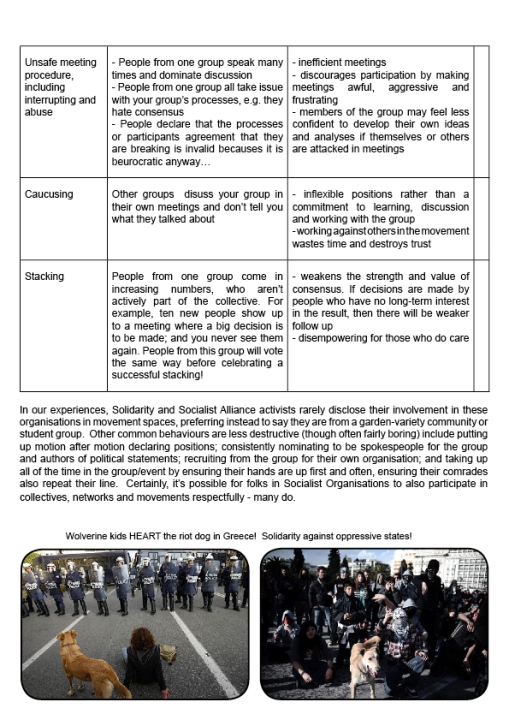For this article, I tracked down a handful of people’s stories of a range of entryist strategies: from the Nuclear Disarmament Party in the 1980s, to the emergence of the NSW Greens Party, the Jabiluka uranium mine campaign, the new Community Climate Network, and Climate Camps. I called folks who were involved in the group at the time for a conversation. All of them are still grassroots activists. I’ve not doubt there are other interpretations of history and I haven’t done in depth historical research – these are just snippets of people’s experiences. [This is abridged version – there is a longer version here.]
I have been active in social movements for about a decade – in student groups and community climate justice networks – and have faced a variety of strategies from Socialist organisations. Sometimes we have been able to work together, and some members have been our friends and allies; but I have found their behaviour as a faction in collectives – or as an organisation at conferences, summits and large actions – to be difficult, disruptive and destructive.
Sometimes it’s hard to pinpoint exactly what it is, or understand why they might be interested in our groups. It’s been helpful for me to talk to people in Socialist organisations/factions about their organisational structure, and understand how they think change happens. [Mostly, the response is: ‘building the revolutionary workers’ party that can get masses of workers onto the streets’].
It’s also been helpful to know these tactics and interventions have been happening for decades (and longer!): there are lessons to be learnt. [In fact, resistance to organised “entryism” has been around since Trotsky’s first proposed the strategy in his essays on “The French Turn” in 1934. The intervening French Trotskyists faced some resistance as they attempted to dissolve their organisation into the French Socialist Party, however they still managed to significantly raise their group’s membership. But, soon after, the French Socialist Party began to expel the Trotskyists. Hooray! …Or not? Anyhoo, I think the take home message here is, “You are not alone. This has been happening since forever.”]
Currently, the strongest ‘entryist’ organisations in the burgeoning climate movement in Sydney are Solidarity and Socialist Alliance (which is mostly made up of people from the Democratic Socialist Perspective (DSP) and their youth wing, Resistance). So far, Socialist Alternative have participated very little in Sydney-based climate organising.
But interventionist or ‘entryist’ strategies are not new to these organisations and political tendencies. Sourcewatch describes entryism as “a political tactic in which an organisation or group enters a larger organisation in an attempt to gain recruits, gain influence or to take control of the larger organisations’ structure. Characteristically, these groups intervene in single-issue campaign groups, and sometimes cause folks to spend more time on dealing with internal wrangling, than with organising work itself.
Beyond individual groups, both organisations currently prioritise participation in ‘peak’ decision-making spaces, in which many groups participate (campaign alliances, national network committees, committees to organise major rallies or large movement events like Climate Camp). They also prioritise student spaces, which they identify as the key grounds for recruitment to their organisation. Student environment collectives – some of the only active networks to survive the Howard Government’s gutting of student unionism – are seen as the largest and strongest student movement, and have faced sustained and sometimes aggressive entryism.
Recently, Wenny Theresia wrote of participation in the growing community climate movement, “An organisational philosophy of groups like Socialist Alliance and Solidarity seems to be seeing highly-charged, lengthy and (deliberately) polarised debates – dominated by a few, pre-caucused positions of these organisations – as ‘politicising’ and beneficial for the movement. Personally I’ve generally found these methods patronising, counter-effective, frustrating and often predictable: not a method that supports critical, grassroots discussion of ideas and consensus decision-making.”
To be fair, it’s possible some ordinary, new or younger members are completely unaware of the entryist tactics and strategies their organisations employ; while others don’t take issue with manipulating other groups for their own agendas (but see this as useful work to ‘politicise’ or ‘radicalise’ what they see as ‘liberal’ groups). I acknowledge members of these organisations have a right to put forward their views, act around their beliefs and join social change groups. But such groups also have the right to defend themselves – and defend consensus-based and non-hierarchical organising structures – against those who undermine them by participating with ulterior motives and hidden agendas.
Nuclear Disarmament Party 1985
In the 1984 Federal Elections, 642,435 people had cast their primary vote for the Nuclear Disarmament Party: it was a new political party, hastily put together and fast gaining thousands of members. They won one Senate seat (Western Australia’s Jo Valentine, with Peter Garrett almost winning their second).
Before the Conference – defending the NDP
The March 1985 Newsletter of the Sydney branch of the Nuclear Disarmament Party reported that members of the Socialist Workers Party (later called the Democratic Socialist Perspective, and today forming the Socialist Alliance) were trying to take over the NDP by entryism and block-voting. The November 21 issue of the newspaper of the SWP and Resistance announced its entire staff had joined the NDP.

